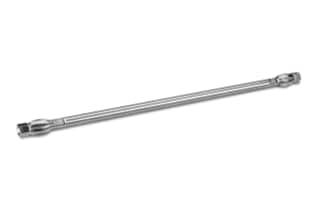
|
Chemistry |
C4 |
|
Separation Mode |
Reversed Phase |
|
Particle Substrate |
Hybrid |
|
pH Range Min |
2 pH |
|
pH Range Max |
10 pH |
|
Maximum Pressure |
6000 psi (415 Bar) |
|
Endcapped |
No |
|
Silanol Activity |
Low |
|
Molecular Weight Range Max |
150000 |
|
Particle Shape |
Spherical |
|
Particle Size |
3.5 µm |
|
Endfitting Type |
Waters |
|
Pore Size |
300 Å |
|
QC Tested |
Protein |
|
Format |
Column |
|
Surface Area |
90 |
|
System |
HPLC |
|
Particle Technology |
BEH |
|
USP Classification |
L26 |
|
Inner Diameter |
4.6 mm |
|
Length |
250 mm |
|
Carbon Load |
8 % |
|
UNSPSC |
41115709 |
|
Application |
Protein |
|
Brand |
XBridge |
|
Product Type |
Columns |
|
Units per Package |
1 pk |

XBridge Protein BEH C4 Column, 300Å, 3.5 µm, 4.6 mm X 250 mm, 10K - 500K, 1/pk
Benefit from the XBridge Protein BEH C4 Column’s Protein Separation Technology which incorporates BEH technology and uses synthetic particles that offer the highest quality combined with consistent performance.
The XBridge Protein BEH C4 Column is QC tested with a peptide map to ensure the stability of peptide separation methods. This is made possible using well-characterized, state-of-the-art bonding procedures for the C18 ligand. In addition to this, it guarantees predictable behavior with the variety of samples that are used in proteomics, protein characterization, and peptide synthesis. The resulting analytical column offers consistent batch-to-batch synthetic peptide and protein digest separations. The manufacturing techniques used for the lab equipment ensure stable particle structure and bonding chemistry from pH 1 to 12 and at elevated temperatures.
Get exceptional separation of a wide variety of peptides using the XBridge Protein BEH C4 Column. It also delivers narrow and symmetrical peaks for maximum resolution. For optimal chromatography, the XBridge Protein BEH C4 Column provides superior peak shape and retention in formic acid and trifluoroacetic acid.
To find more variants of the product listed here, products compatible with it, and to shop for lab equipment, browse through our catalog. It will also enable you to reach out to our offices worldwide and contact members of our staff should you have any queries regarding the products or the technology.
You may also be interested in LCGC Certified Clear Glass 12 x 32 mm Screw Neck Vial, with Cap and Preslit PTFE/Silicone Septum, 2 mL Volume, 100/pk that makes it possible for you to store your analytes, samples, and solutions in a chemically inert vial so that you get reliable and interference-free results from your analysis. All Waters LC/GC certified vials are also UV-tested by HPLC, the test used to detect trace levels of chemicals used in packaging and manufacturing processes.
What Happens When A Protein Precipitates?
Precipitation can occur due to a change in pH or if the hydrophobicity alters interactions between the protein and the aqueous environment. It can also happen through binding of salts or metals to protein functional groups such that intramolecular interactions are disrupted. As a result of this precipitation, the proteins denature, aggregate, and fall out of solution.